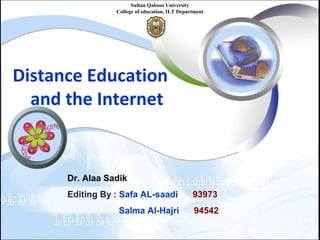Distance Education and the Internet
- 1. Distance Education and the Internet Sultan Qaboos University College of education, ILT Department Dr. Alaa Sadik Editing By : Safa AL-saadi 93973 Salma Al-Hajri 94542
- 2. Defining Distance Education Background: 1.The Industrial Revolution in the 19th century (see Wikipedia) → 2.Developments in various fields of technology (give examples) → 3.Offered new solutions for delivering instruction → 4.Learners’ interests (in what?) were enhanced → 5.Increase in the subject areas offered by distance education → 6.Became one of the formal means of education.
- 3. Defining Distance Education What is distance education or distance learning? •(Web definitions) Distance education, or distance learning, is a field of education that focuses on the pedagogy, technology, and instructional system designs that aim to deliver education to students who are not physically "on site" in a traditional classroom or campus. en.wikipedia.org/wiki/Distance_education
- 4. Defining Distance Education ‘a term that covers the various forms of study at all levels which are not under the continuous immediate supervision of tutors present with their students in lecture rooms, but which, benefit from the planning, guidance and tuition of a tutorial organisation’ (Holmberg, 1977, p. 9).
- 5. Defining Distance Education • Distance education is a method of education in which the learner is physically separated from the teacher by space and time. • Distance education materials are often structured in ways that facilitate learning at a distance. Rumble (1989)
- 6. Defining Distance Education • the majority of educational communication between the teacher and students occurs non-contiguously. • involve two-way communication technology between the teacher and students for the purpose of facilitating and supporting the educational process. Garrison and Shale 1990, p. 25
- 7. In Conclusion • The separation of teacher and learner; • The separation among learners; • The use of technology to deliver the subject matter; and • The use of a communication channel to facilitate interaction and support learners.
- 8. Defining Distance Education Distance education or distance learning? In our point of view , we think that , Distance education could be distance learning because distance education is more general than distance learning , So , distance learning could by a part of distance education . Distance education is well-organized system and formal ( for example: distance education in university –college) . Distance learning have no frame work ( any one can learn at distance if he-she needs).
- 9. Defining Distance Education The history of distance education could be tracked back to the early 1700 in the form of corresponding education , but technology -based distance education might be best linked to the introduction of audiovisual devices into the school in the early 1900s . History of distance education and technology (old technology)
- 10. Defining Distance Education History of distance education and technology (modern technology) The change in distance learning over the past 30 years can be easily observed . Corresponding courses relied on a combination of paper based and surface mail communication . The 1950's this was the sole method of distance learning . When television and radio were used , they were one-way media , enabling the teacher to present information , but with no interaction between the presenter and the audience. As more sophisticated technologies became available , teachers began to interact with their dispersed groups.
- 11. Defining Distance Education Time for Presentation
- 12. Defining Distance Education In conclusion, many key features characterize distance education: 1. The separation of teacher and learner; 2. The separation among learners; 3. The use of one medium to deliver instruction; and 4. The use of a communication channel to facilitate interaction and support learners.
- 13. The End












